Automatic feeders are a godsend for cat owners with a busy lifestyle, ensuring that their furry friends are fed regularly without fail. (1)
They are designed to dispense food at scheduled intervals, providing an easy way to manage your cat’s dietary needs even when you’re not around.
But what happens when your cat won’t eat from automatic feeder and turns up their nose at this technological marvel?
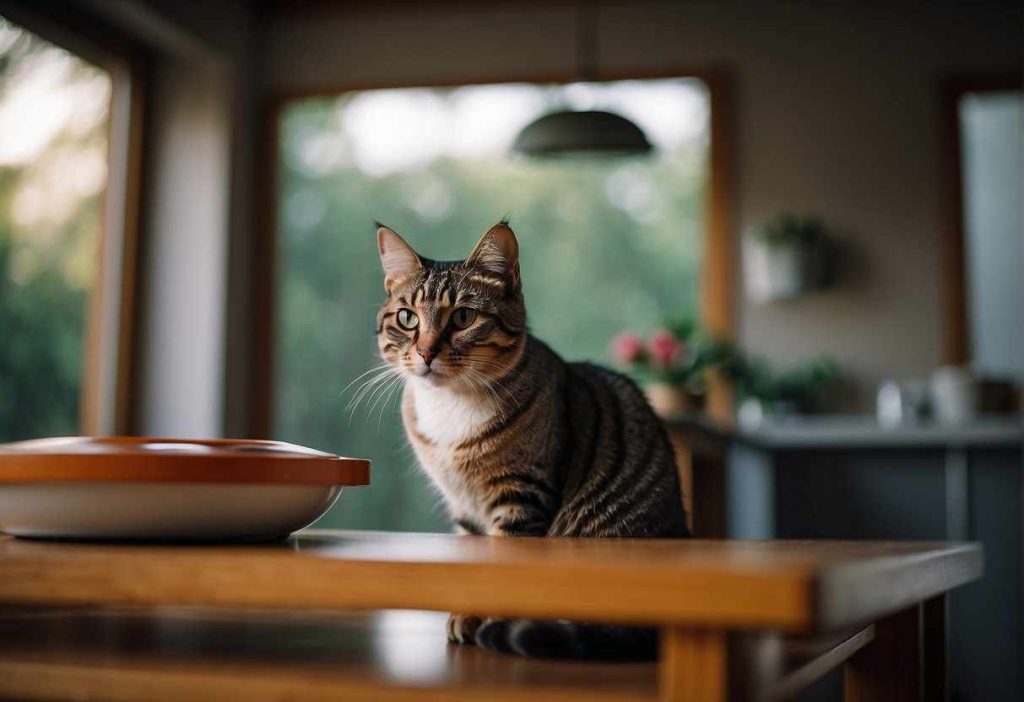
It’s not uncommon for some feline companions to be wary of their automated counterparts. If your cat is giving the cold shoulder to the automatic feeder, you’re not alone in this predicament.
It can be both worrying and frustrating when your cat decides they’re not a fan of their new gadget. After all, you invested in your cat’s health and well-being, but they seem unimpressed.
The aim here is to tackle this whisker-tingling issue head-on.
With a wealth of advice and practical tips, the article seeks to guide you through the possible reasons your cat is boycotting the automatic feeder and outline strategies to change this behavior.
From examining environmental factors to personalizing your approach or seeking professional help, we’ll cover all the avenues that could lead to a happy cat and a functional feeder setup in your home.
Key Takeaways
- Automatic feeders offer convenience but some cats may initially refuse to use them.
- Understanding and addressing your cat’s hesitation is key to encouraging acceptance.
- Professional advice may be sought if standard solutions don’t resolve the issue.
Cat Won’t Eat from Automatic Feeder: Behavior and Environmental Influences
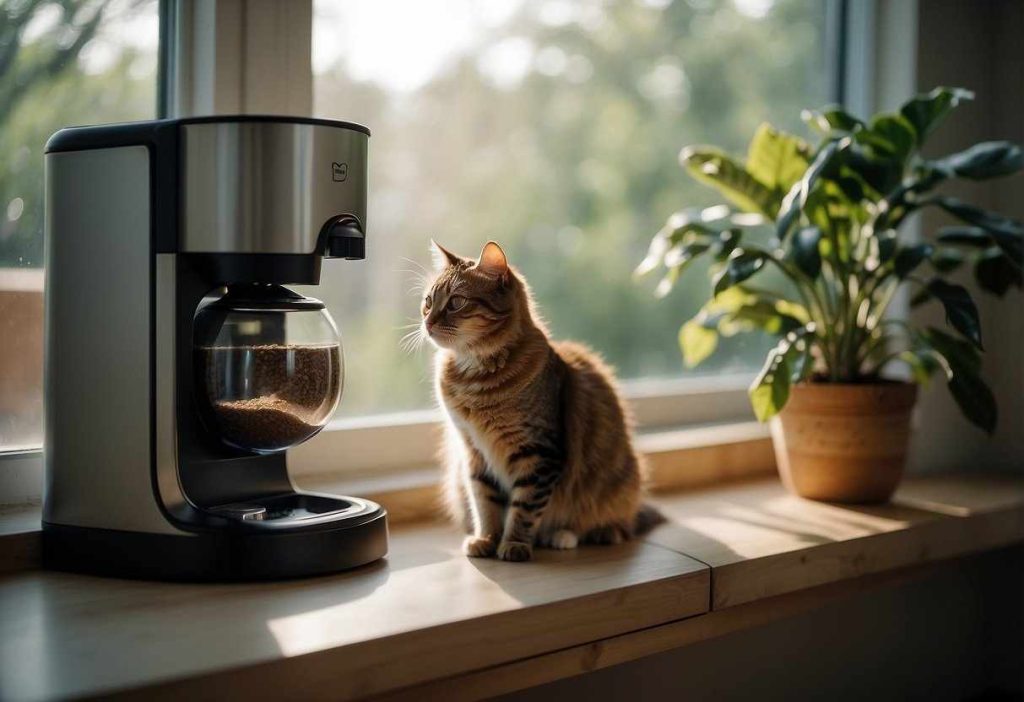
Detailed Behavior Modification Strategies:
- Start Slow:
- Day 1: Place the feeder, turned off, near your cat’s regular dish. Let curiosity do its thing.
- Day 2-4: Hide a treat or two in the feeder tray – a sneaky surprise to spark interest!
- Add Familiar Touches:
- Place a blanket or toy by the feeder, something with a comforting, familiar scent.
- Introduce Sounds:
- Turn the feeder on so your cat gets used to the buzzes and whirrs without the scare.
- Associate Feeding Times:
- Once relaxed around the device, schedule feedings, and offer praise when your cat approaches.
Rome wasn’t built in a day, and neither is a cat’s trust in robot feeders.
Be patient, offer plenty of high-fives and chin scratches, and keep up the encouragement.
Mitigating Psychological and Environmental Barriers:
Time to play interior decorator with a side of cat whisperer. Create a zen zone for your kitty’s chow time with these tips:
- Feeder Placement:
- Find a quiet spot, away from foot traffic and noisy appliances.
- Minimize Spooky Sounds:
- Opt for a feeder model known for its quiet operations, or place a comfy mat underneath to dampen noises.
By following these steps, you’ll have one happy, feeder-friendly feline. Here’s to moving from skeptical to “Seconds, please!”
Customizing Feeder Use for Your Cat

Technical Solutions and Customization
First things first, let’s make this automatic feeder feel familiar. Cats are creatures of habit, so why not align the feeder’s dispensing schedule with your cat’s regular meal times?
Grab a coffee and spend some time with the manual:
- Adjust Settings: Match the feeder’s settings to your cat’s usual mealtimes and portion sizes. (2)
- Test Dispensation Speeds: Some cats could be startled by a sudden food avalanche. Start slow and see how your cat reacts!
Implementing Multi-Cat Dynamics and Feeder-Sharing Solutions
Living in a multi-cat household? You’re probably a master of negotiation! Sharing isn’t always in a cat’s vocabulary, but we can certainly teach it:
- Scheduled Feeding: Coordinate feeding times to prevent feline fracas. (3)
- Feeder Placement: Separate feeders can reduce tension. Try placing them in different rooms. (4)
- Monitoring Interaction: Keep an eye on the feeders’ first few uses to ensure a peaceful mealtime.
Remember, the goal is stress-free access to food. Your cats should feel at ease with their new gadget.
It may take a little trial and error, but soon enough, they’ll wonder how they ever lived without it. Happy feeding!
Learning from Others’ Experiences
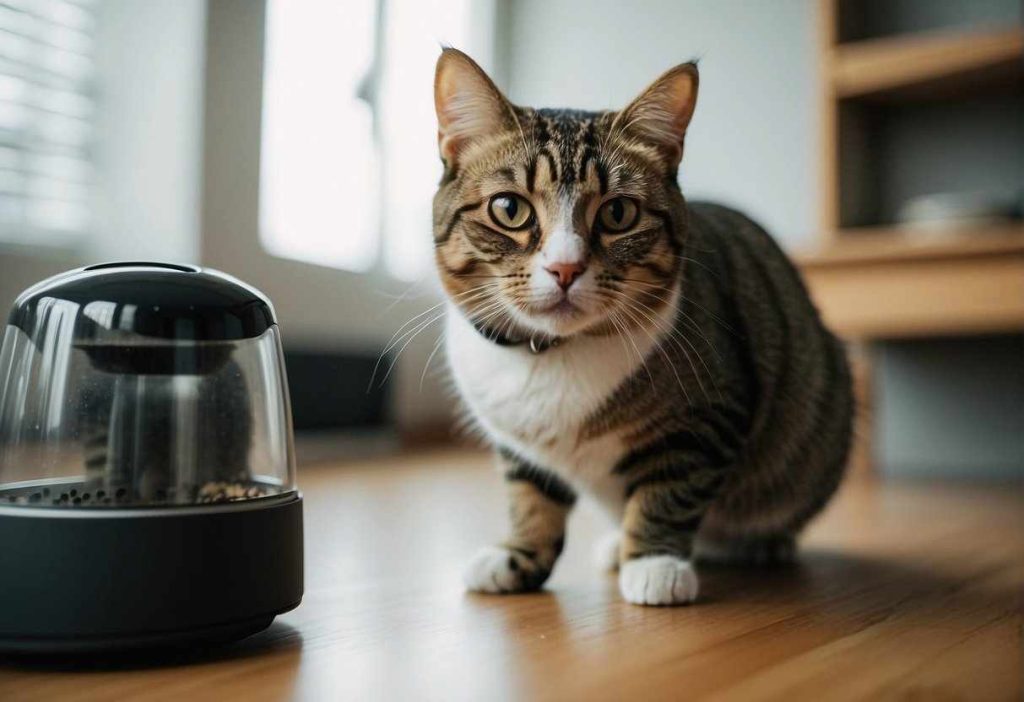
Meet Sarah, a savvy cat owner who found her kitty, Whiskers, turning up her nose at the new automatic feeder. All it took was a pinch of patience and a sprinkle of creativity to solve this feline puzzle.
Sarah placed Whiskers’s favorite toy near the feeder to make mealtime fun again. The result? A happy, well-fed cat.
Then there’s James, whose cat, Simba, wouldn’t touch the food if he didn’t see his human fill the bowl.
James tricked Simba’s senses by pretending to refill the automatic feeder daily. Sneaky? Maybe. Effective? Absolutely!
Here’s a quick rundown of the top tricks these cat whisperers employed:
- Keep it Fun: Play is a big part of your cat’s day. So why not integrate it with feeding?
- Toy Placement: Put a beloved toy by the feeder.
- Feeder Fun: Create a game around the automatic feeder.
- Maintain Routine: Cats love predictability, just like that morning coffee you need to function.
- Visual Cues: Hide the food, but pretend to “fill” the feeder at the usual mealtime.
- Sound Cues: Record and play the sound of kibble being poured.
- Mix & Match: Combine different methods to find the purrfect solution for your picky eater.
| Problem | Creative Solution |
|---|---|
| Ignoring the feeder | Place familiar objects around the feeder |
| Distrust of new gadgets | Mimic old feeding habits |
| Fear of strange, mechanical noises | Introduce feeder sounds gradually |
Remember, it’s all about trial and error. With a dash of imagination and a spoonful of love, you’ll have your cat dining à la automatic in no time!
When to Seek Professional Advice
It might be time to tap into some expert wisdom:
- Continued refusal to eat: If more than 24 hours pass and your cat is still giving the cold shoulder to their automatic feeder, it might not just be a feline fad.
- Behavior changes: Is your kitty acting more like a scaredy-cat? Hisses, retreats, or general skittishness around their feeder can signal something’s up. (5)
- Weight loss: If the numbers on the scale are dipping for your cat, that’s a clear sign to step in.
So, why buzz a pro? Let’s look at some quick perks:
- Tailored advice: Vets and behaviorists can serve up personalized guidance that fits your cat like a glove. (6)
- Peace of mind: Rule out any health concerns that might be knocking your cat’s appetite off-kilter.
- Happy habits: Professionals can help train your cat to be best buds with their new gadgets.
| Signs to Watch | Action to Take |
|---|---|
| Not eating for 24+ hours | Call the vet ASAP |
| Sudden weight loss | Schedule a check-up |
| Stress or anxiety | Discuss with a behaviorist |
Remember, you know your whiskered sidekick best. If you sense they’re not their usual purring self, it’s time to make a call. A healthy cat is a happy cat, and you want to keep those purrs coming strong!
Understanding the Automatic Feeder Dilemma
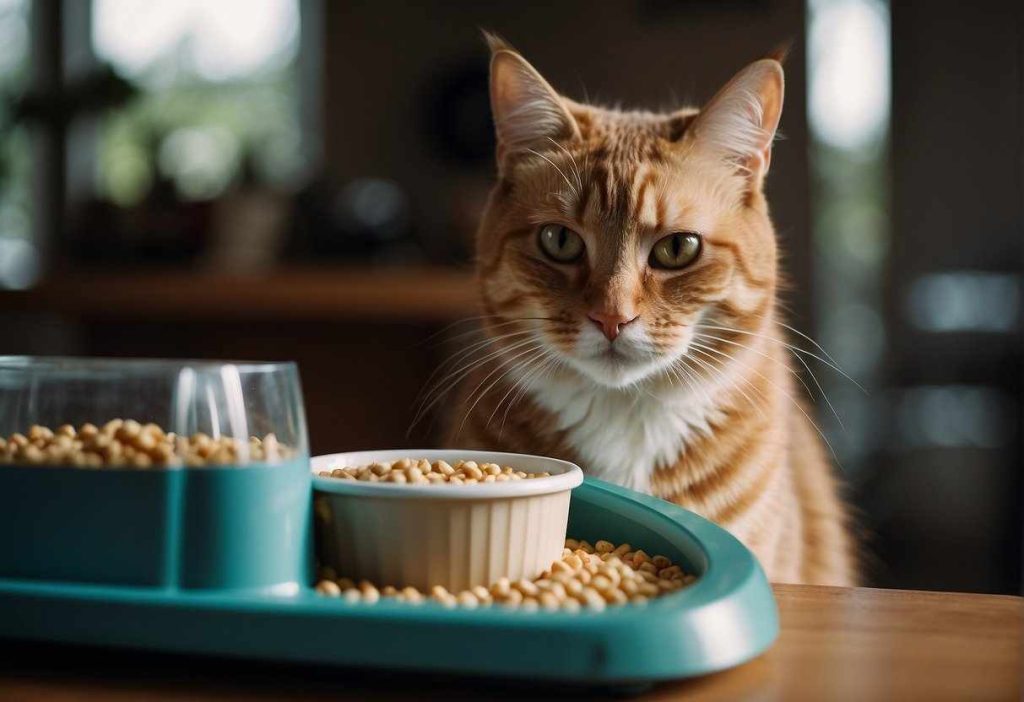
Automatic feeders are designed to dish out food at set times, which sounds convenient, right? But here’s the rub: your cat can be skeptical of this newfangled contraption.
Cats are creatures of habit, and a sudden change, like a mechanical feeder, can throw them for a loop.
If you’ve noticed your whiskered companion giving the new feeder the cold paw treatment, here’s what might be happening:
- Curiosity vs. Caution: Cats are curious but cautious. They might eye the feeder suspiciously before deciding it’s safe.
- Noise Factor: These feeders can be noisy, which might spook your kitty.
So, what do you do when your cat is just not that into their new diner? Look out for these signs:
- Body Language: Are their ears back and whiskers twitching?
- Eating Habits: Are they approaching the feeder but not eating, or perhaps eating less? (7)
Here’s a quick checklist to decipher the dilemma:
- Observe how your cat approaches the feeder.
- Take note of any anxious behavior or hesitance.
- Check if the feeder’s operating noise is causing distress.
Remember, patience is key. Give your cat time to adjust. Who knows? With a little encouragement, they might just become best buddies with their automated buddies.
Selecting the Right Automatic Feeder

When you’re looking for an automatic feeder for your kitty companion, it’s like you’re picking a new robotic pal! Let’s break down the essentials to keep an eye out for.
- Silent Operation: Cats have a ninja-level hearing! A feeder that’s as noisy as a vacuum cleaner will probably scare them off. Opt for a quiet model.
- Ease of Cleaning: You don’t want to spend hours scrubbing, right? Look for feeders that have dishwasher-safe parts.
- Food Compatibility: Whether your feline friend is a kibble cruncher or a soft food fan, make sure the feeder can handle it.
Avoiding Pitfalls: Hey, it’s super tempting to grab that budget feeder that’s shouting “bargain,” but wait!
Cheap might mean frequent malfunctions. Plus, the feeding mechanism matters. A chunky kibble dispenser might frustrate your tiny treat lover with its mega-sized portions.
Here’s a quick checklist to ensure you’re not missing out:
- Noise level as quiet as a mouse?
- Easy-peasy cleaning?
- Suitable for your cat’s favorite snacks?
Remember, this isn’t just a gadget, it’s a part of your cat’s daily life!
Quick Recap

Adult Cats & New Gadgets: Adult cats can be a bit set in their whisker-y ways. But don’t fret; it’s all about baby steps.
Gradually introduce the feeder alongside the old bowl and pop in some irresistible treats.
- Favorite Meals: Use the feeder for their most-loved noms. Imagine it’s like getting your favorite takeout from a new app. Pretty tempting, huh?
- Consistent Scheduling: Cats are little furry creatures of habit. Try to schedule meals at the same time each day to set a routine.
- Scent Matters: Give the feeder a rubdown with a cloth that smells like you or them, to weave in a sense of familiarity.
Encouragement and Support
Remember, patience is key. Most kitties will come around with the right encouragement. You’ve got this!
Feeling equipped? If your plan works or even if it flops, don’t be shy! Drop your tales and tips in the comments below. After all, sharing is caring, and we’re all in this cat conundrum together.
Frequently Asked Questions
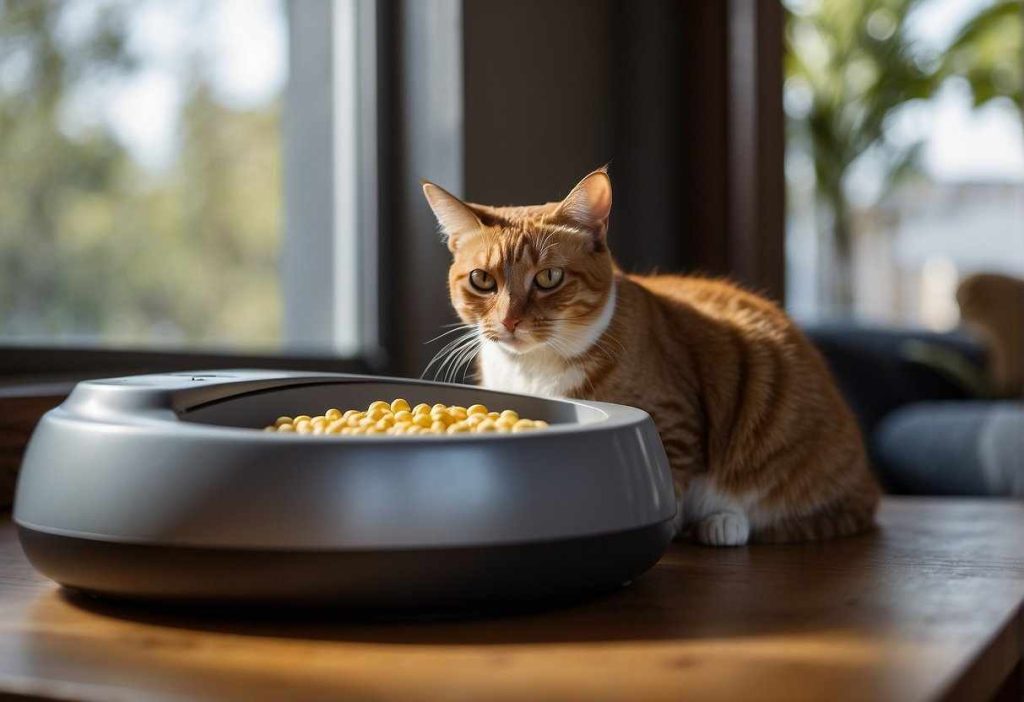
Encountering issues with your cat and their new automatic feeder? Don’t worry, it’s common, and there are ways to help your feline friend adjust. Let’s tackle some of the most common concerns you might have.
Why won’t my cat eat from the automatic feeder?
It’s possible your cat is uneasy with the new device. Cats are creatures of habit and may be skeptical about a new source of food.
Ensure the feeder is in a quiet location and resembles their regular feeding bowl to make the transition smoother.
How can I encourage my older cat to eat from a new automatic feeder?
Older cats can be particularly set in their ways. Start by placing treats in the feeder’s bowl to create a positive association.
Gradually mix in their regular food with the treats over time.
What should I do if my cat is fascinated by the automatic feeder but refuses to eat from it?
Your cat may be curious but still hesitant. Try hand-feeding them beside the feeder during its dispensing times to build a routine and link the feeder with feeding time.
Can using an automatic feeder affect my cat’s affection towards me?
Not necessarily. While the feeder takes over the role of providing meals, your affection and playtime with your cat are what truly build your bond.
What are the steps to train a cat to eat from an automatic feeder?
1. Introduce the feeder without any food in it so your cat can explore without feeling pressured.
2. Place a few favorite treats in the feeder to pique interest.
3. When comfortable, add a mix of treats and food at their usual feeding time to establish a routine
If my cat only eats when hand-fed, how can I transition him to an automatic feeder?
Start by placing your hand near the feeder’s bowl, slowly moving it away with each feeding.
Gradually increase the distance until your cat is comfortable eating without your hand nearby.
What should I do if my cat is afraid of the noise the feeder makes?
Choose a feeder with a quiet dispensing mechanism.
You can also record the sound of the feeder and play it at a low volume outside of feeding times to acclimate your cat to the noise.


